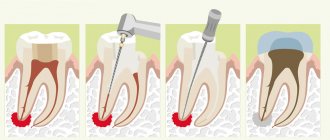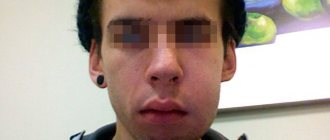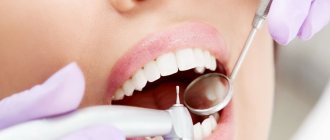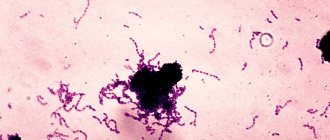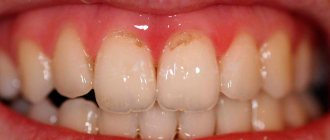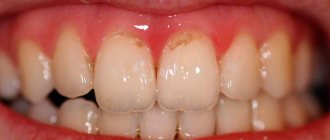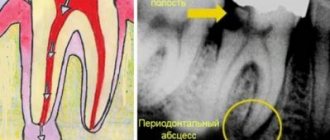Tooth granuloma
Granuloma on the root of a tooth - what is it and why does it appear? Granuloma is an inflammatory formation that affects part of the root. It is the initial stage of a granular cyst and differs from it only in its smaller size. The disease is characterized by the formation of a purulent sac of granular tissue. The sac is surrounded by a fibrous capsule that connects to the apex of the tooth root.
The appearance of a granuloma under a tooth indicates that an inflammatory process is underway. Before installing dentures, it must be eliminated, otherwise the granuloma will grow under the crown.
The formation of a focus of inflammation in the jaw bone is the body’s defensive reaction to the attack of pathogenic microbes. A dense connective capsule is formed around the lesion, isolating it from the healthy bone. But this protection does not last forever, so granuloma is often compared to a time bomb.
Comments
Once a year I definitely go for an examination with a dentist, and this time he discovered a granuloma... and recommended removing the tooth right along with it!!! How is it possible, why deletion if it was discovered in a short time????
Yulia V. (03/12/2020 at 06:22 pm) Reply to comment
- Yulia, it can be assumed that conservative treatment, as well as surgery with preservation of the tooth, is impossible due to the presence of a root crack, or the inflammation has progressed greatly this year under the influence of other factors (general diseases of the body, stress, hypothermia). Another reason is severe destruction of tooth tissue, in which its preservation is not possible. Try contacting another doctor to compare the results of the study and the proposed methods for solving the problem.
Editorial staff of the portal UltraSmile.ru (03/20/2020 at 09:09) Reply to comment
If the dentist advises surgical removal of the granuloma, how long does the healing process take and what complications may occur? I’m worried that I’ll have to take time off from work; after all, this is an operation, albeit of a local nature.
Tatyana (03/20/2020 at 07:53) Reply to comment
Recently at an appointment I was diagnosed with a granuloma. But the dentist suggested only one way - tooth extraction. He said that during treatment there are no guarantees that in a year the tooth may have to be removed anyway. How justified is this? Maybe you should contact another specialist?
Lydia (03/20/2020 at 08:37) Reply to comment
Is it really necessary to take a panoramic photo twice a year? I think that a competent dentist, during an annual examination if there are complaints, should recommend this procedure. And then do it.
Peter (03/20/2020 at 10:00) Reply to comment
Good afternoon! I don’t quite understand whether granulomas can appear due to caries? I have small caries on several teeth, as the dentist told me that there is no need to rush into treating them. Is it so?
Dmitry Ch. (03/20/2020 at 10:50) Reply to comment
Please tell me, is there any way to prevent the appearance of this granuloma? Are there any methods of prevention? Is surgery performed under local anesthesia? How immediately after detecting a source of inflammation?
Ksenia (03/20/2020 at 11:42 am) Reply to comment
I went to the doctor for dental treatment, a granuloma was discovered, and the tooth had to be removed. Although literally six months ago there was a scheduled examination. Couldn't granuloma have been detected then?
Elizaveta (03/20/2020 at 11:46 am) Reply to comment
Hello. So what causes a granuloma to appear initially? And is it necessary to check with a dentist twice a year if you have no caries, no plaque, etc.? For example, I didn’t just go to the dentist at all.
Baht (04/23/2020 at 07:39) Reply to comment
I had granuloma; it could only be cured surgically and the process was very long and painful. Now I'm worried that the disease may return. Is there such a chance if I lead a healthy lifestyle and do not have chronic diseases?
Olga (04/23/2020 at 08:13) Reply to comment
That is, it is also visible only in the picture? Horror. I undergo preventive maintenance at the dentist every six months, but I don’t take a picture, just a superficial examination. Looks like I'll have to take some photos too.
Valentin (04/23/2020 at 09:05) Reply to comment
They diagnosed me with a granuloma and told me to warm it up, but it’s not getting any easier. Don't touch the tooth. What to do?
Ekaterina (04/20/2021 at 12:29 pm) Reply to comment
Write your comment Cancel reply
Symptoms
Even having an idea of what dental granuloma is, its symptoms are not so easy to determine. The fact is that the disease may not manifest itself for a long time. The tooth under which the formation is located may not outwardly stand out in the dentition. The gums may also look quite healthy.
In some cases, the disease is accompanied by the following symptoms:
- swelling of facial tissues;
- swelling of the gums;
- slight increase in temperature;
- the occurrence of flux;
- acute pain in the area where the granuloma has formed;
- slight discharge of pus between the tooth and gum;
- pain in the eyes, migraine, dizziness;
- On palpation there is acute pain.
Good to know. Granuloma often makes itself known if a person has had a cold, flu, pneumonia and other diseases that lead to a decrease in immunity.
Diagnosis of purulent pulpitis
First of all, the dentist listens to the patient’s complaints and examines his oral cavity. If during the examination the patient experiences a painful reaction, there is a smell of pus from the oral cavity, and the dentin in the cavity of his tooth is softened, this is a reason to send the patient for an x-ray, which will confirm or refute the diagnosis, and will also allow one to assess the depth of the process. Also, the dentist should be alert to the light shade of dentin or its pigmentation. Often, a diseased tooth and the mucous membrane around it are covered with a white coating, swelling is observed in the transitional fold, and if you press on the tooth, pus may be released.
It is very important to correctly diagnose a disease such as purulent pulpitis, because it is quite easy to confuse it with other dental diseases. Among them:
- Diffuse or focal pulpitis in acute form. This disease is characterized by the absence of pus when opening the dental cavity and not so long-lasting pain.
- Purulent periodontitis. In this case, the patient will experience short-term sharp pain in the tooth, especially when biting.
- Trigeminal neuralgia. Pain at night is not typical for this disease, and it is not aggravated by various temperature stimuli. Most often, painful sensations with this disease appear as a result of touching the skin of the face in certain places.
Causes of granuloma
What causes dental granuloma? Among the main factors provoking the formation of a focus of inflammation, the following should be highlighted:
- treatment of pulpitis was carried out poorly (for example, tissues affected by caries were not completely removed);
- the dentist filled the root canals in violation of the rules of asepsis and antisepsis;
- the tooth was injured directly due to damage to the maxillofacial area, unsuitable orthodontic design or for other reasons.
Why does it occur
Among the main causes of pathology:
- advanced caries;
- jaw injuries;
- illiterate root canal treatment;
- overload of individual units as a result of poorly performed prosthetics;
- congenital anomalies of the upper/lower jaw;
- infections of the nasopharynx and oral cavity.
Regardless of the characteristics of the provoking factor, a gum cyst should be treated under the supervision of a dentist. Self-medication for this diagnosis is unacceptable.
How is dental granuloma diagnosed?
Diagnosis at an early stage is almost impossible. Even a dentist with extensive experience will not always be able to visually determine the occurrence of a granuloma under a tooth; this will require additional research. Most often, a neoplasm is discovered completely by accident during radiovisiography, which was prescribed for a completely different purpose.
To confirm the diagnosis, the patient is prescribed radiography. Using this study, it is possible to differentiate dental granuloma from other diseases. In the picture, the source of inflammation and its location will be clearly visible. Based on the results of the study, the most suitable treatment method is prescribed.
In the photo you can see what granuloma of the gums and teeth is and what it looks like.
It is important to know. Unfortunately, it is not always possible to save a tooth under which a cyst has formed. If the tooth is already partially destroyed or has a vertical crack, it must be removed.
Traditional methods and treatment at home
The use of traditional methods in the treatment of granuloma can lead to complications and irreparable consequences.
Under no circumstances should hot compresses be applied to the cheek on the side of the inflammation: this will accelerate the spread of pus. Even if you know the names of antibiotics used in the treatment of tooth root granuloma, you should not take them yourself. Treatment methods should only be chosen by a doctor.
The only thing that can be done while it is not possible to get an appointment with a doctor (for example, symptoms appeared late in the evening) is to take a Nurofen or Ketanov tablet to eliminate the pain.
You need to understand that the development of inflammation occurs inside the root canals and in the jaw, which cannot be reached by any folk remedies, and only the help of a specialist will help save the tooth.
Treatment options for granuloma
Treatment of the tumor consists of eliminating the source of infection and preventing relapse. Therapeutic and surgical techniques are used.
Therapeutic method
It will bring results only if the disease is detected at an early stage. The patient is prescribed antibiotics and sulfonamide medications. Timely treatment will help eliminate the infection and save the damaged tooth.
Non-surgical method
It appeared relatively recently, the essence of the method is as follows: the affected tooth canal is expanded and a substance is introduced into it that destroys the infection.
Surgical method
It is used if the granuloma has grown greatly and the use of drug therapy will be ineffective. During the operation, the dentist cuts the gum to allow pus to come out. Then a drainage is installed in the tooth, which the patient must endure for three days. Also during this period, drug therapy is carried out. After three days, another operation is performed, during which purulent sacs, tumors, or a tooth root with a cyst are removed. Then the doctor makes a decision about the fate of the tooth: it is either left or removed.
Removal is necessary in the following cases:
- the tooth is so damaged that it can no longer be restored;
- root canals cannot be treated;
- the cause of inflammation was problems in the periodontal pocket;
- the patient is undergoing a prosthetic procedure;
- cracks have formed in the area of the tooth or its root;
- There are multiple perforations of the tooth.
In other cases, doctors try to save the tooth.
Treatment of a cyst on the gum of a child
Regardless of the reasons for which a cyst appears on the gum, it needs to be treated. Treatment may be medication or surgery.
Therapy involves the use of:
- antiseptics in the form of a solution for rinsing or sprays;
- painkillers;
- antibiotics;
- anti-inflammatory drugs that relieve swelling;
- ointments used for healing.
If drug therapy does not show the expected effectiveness, the doctor may decide on surgical intervention (in some cases, surgery is prescribed immediately, since this is a more effective method of treatment). Modern developments in medicine make it possible to perform operations using a laser, which makes the process completely painless for the patient.
Expert advice and recommendations
Having figured out what kind of disease this is - dental granuloma, you can protect yourself from it. To do this you need to follow a few simple rules:
- undergo preventive examinations every 6 months;
- contact your dentist in a timely manner if any unpleasant symptoms from the dental system occur;
- treat caries at an early stage;
- carry out hygiene procedures regularly;
- change the brush monthly.
Dentists at the Saint-Dent Clinic in Moscow will offer patients a modern and comprehensive approach to the diagnosis and treatment of dental granuloma. Only the most effective treatment methods and high-quality materials are used. You can find out the cost of services here PRICES. The contact section is located here CONTACTS.
Surgery to remove a cyst in the gum
If therapeutic procedures do not help, then surgical intervention is used to treat cysts in the gums, and in most cases this is what happens, since patients seek the help of doctors when the disease is in an advanced stage. First, an x-ray is taken, based on the results of which the method of removing the cyst in the gum is determined:
- cystectomy - complete removal of the cyst and part of the root;
- hemisection – the disease, part of the tooth and root are removed, restoration is performed using a crown.
If the root and tooth are not damaged, then superficial surgical intervention is used, that is, the cyst is incised and all the pus is sucked out, the wound is disinfected and sutured.


